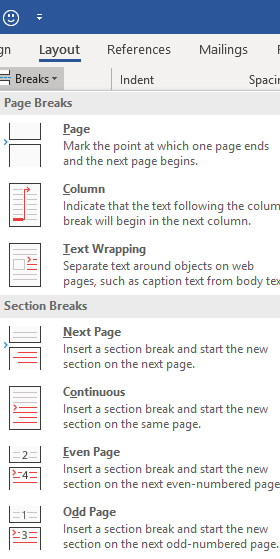From the very beginning, Word users have had the ability to create tables in their documents to easily organise information in neatly aligned rows and columns. Word tables can also be easily modified, if you need to add or delete rows or columns as your document evolves. You can find all of these actions readily available on the left of the Layout tab attached to the Table Tools at the top-right of the screen. (These actions are also available on the right-click menu when your cursor is positioned anywhere within your table.) Indeed, if all you seek is to add a new row on the end of your table, all you need to do is to position your cursor in the last cell of your table’s last row and then press the Tab key. Your table will immediately grow by one row.
However, you might find a problem emerges if your table needs to extend beyond one page, as might be the case with a longer catalogue or phone listing. As you table extends to a greater length, you may find that most of your table is lacking the context that is provided by the headings on your first row, as in the example below:
| First Name | Last Name | Department | Position | Start Date |
| Hugh | Twelftree | Administration | Accountant | 22/3/2015 |
| Carol | Wellings | Marketing | Director | 18/5/2017 |
| Kim | Magnussen | Production | Manager | 27/10/18 |
As your table extends over two, three or more pages, you will inevitably leave behind the headings in your first row on the table’s first page. What you need is to be able to have the same headings in the first row of your table on each successive page, so that you are able to meaningfully interpret your table data on whatever page you are viewing it. The obvious way of achieving this is to simply copy and paste the headings from the beginning of the table to the first row of the table on each following page.
But the drawbacks to this solution are also obvious. It would be tedious and time-consuming to do this in a long table that might run across numerous pages. And it also becomes problematic if you subsequently add or delete rows to your table, after you have pasted your headings to the appropriate new location. If you do modify your table in this way, it will inevitably mean that your headings will move around and will be out of place.
Happily, there is a better, faster and much more elegant solution. You can create and build your table to whatever length you need or wish. Then, just position your cursor anywhere in your table’s heading row. Go to the Layout ribbon at the top-right of the Word screen and select Repeat Header Rows. As a result, the first row of your table on each page will always display the same headings. And this will continue be the case, even after you add or delete rows to your table as your document evolves; there will be no need to modify your table to retain your headings in the right location. Of course, if you have greater ambitions for your table, particularly if your table is intended to contain numerical data and calculations, then maybe a better choicewould be an Excel spreadsheet. There is a strong argument to be made for using each member of the Microsoft family according to its strength, and for any task involving numbers and mathematics, Excel is really your go-to option Explore this option starting here.



